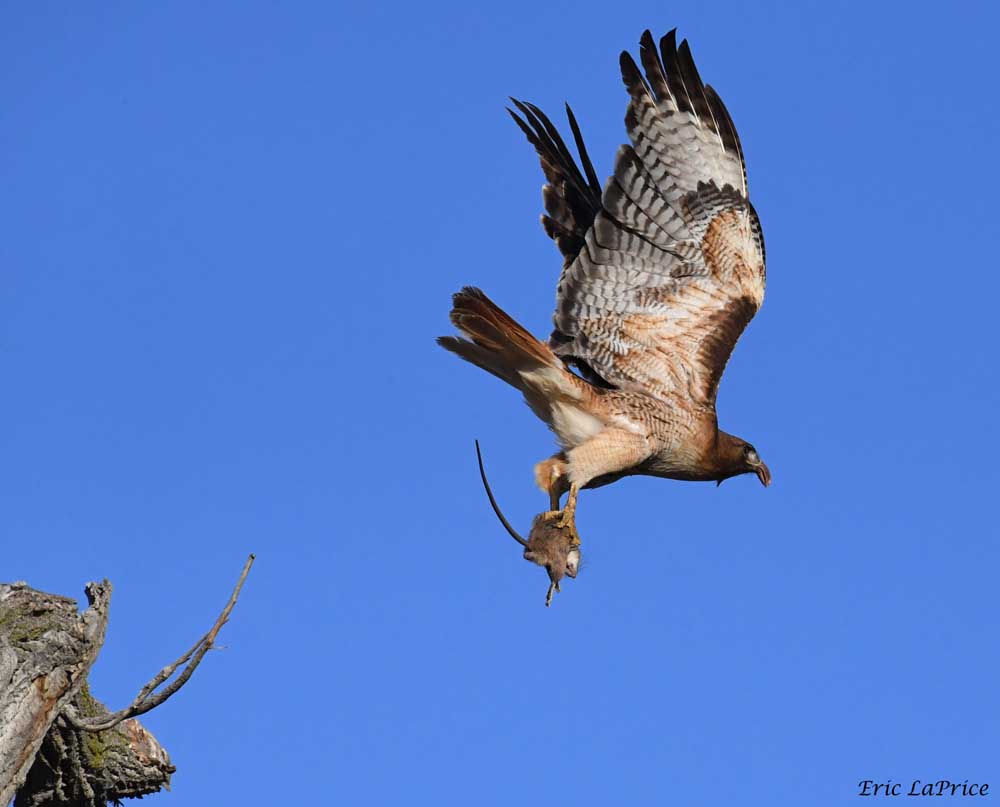On a bright sunny day, a red-tailed hawk (Buteo jamaicensis) sits surveying his domain from the top of the cupola on the barn. We see them everywhere—on top of utility poles, high up in trees, sitting on fence posts, even sitting on the cable barriers that run down the median on the interstate. They hunt during the day, and they’re waiting for a mouse, a vole, a rabbit, or maybe a roadkill to come along. They can also be seen soaring on updrafts, broad, rounded wings spread, ever-watchful for their dinner.
And wow can they watch. They can see a mouse in the grass 100 or more feet below them. Their vision is said to be eight times as acute as a human’s. And not only that, they can see a whole range of ultraviolet colors that we can’t. Their eyes are protected by nictitating membranes that slide across the eye from the inside to the outside corners. These membranes can be closed to keep the eyes clean and also to protect them from the wind when the bird is diving. This is important, since they dive at 120 miles per hour. They also have eyelids which rise up from below, instead of down from above like ours.
I hear their cry—a sharp, descending call that reminds me of the sound a child makes when illustrating something falling or a toy plane landing only louder and sharper.
The red-tailed hawk has a wingspan of four feet. Its wings are designed for soaring. Although they weigh three pounds or more, they look light as a feather as they float effortlessly on those broad, rounded wings, catching updrafts, circling a couple hundred feet above the ground. Their tail is short and squared off and is characteristically a brick red in mature adults. The rest of the bird’s back and wings are anywhere from dark to light brown. Their underside is lighter in color with a darker band across the belly. Their legs and feet are yellow, with their toes tipped by long sharp talons. Like other birds of prey, their beaks are sharp and curved downward, for tearing meat.
All of these features come together to create a killing machine. Their primary diet is small mammals like mice, voles, rabbits and even animals like young raccoons weighing up to five pounds. They’ll catch and eat whatever they can, however, and this has caused a lot of trouble for them in the past.
Farmers called them chicken hawks because they were thought (not without cause) to eat chickens. They were also known to prey on birds that sportsmen prized for hunting. During the 18th and 19th centuries, hunters shot them indiscriminately. Between 1875 and 1890, several states actually put bounties on them ranging from 20 cents to $2 apiece. In addition, their feathers were highly prized by milliners for ladies’ hats. The result was an all-out war on hawks and other raptors. Eventually, in the early twentieth century, bounties were removed and laws were passed to protect hawks including the red-tail.
And then, in the 1940s, DDT was introduced into the environment. Birds, including red-tailed hawks, were heavily impacted. The DDT, which made its way up the food chain to the hawks, caused the shells of their eggs to be too thin to protect the baby birds, and the babies died. DDT was banned in 1972, and laws prohibiting hunting hawks are still in force. This has helped the red-tailed hawk population come back from near extinction. Their dangers today include collision with automobiles, and lead poisoning from the lead pellets used to hunt smaller birds.
In spite of the attitude Iowans had for 150 years regarding the red-tail hawk and its cousins, we adopted and still use a hawk as our mascot.
Back in the 1830s, before Iowa became a state, nicknames for the residents of various places were not necessarily complimentary. Residents of Missouri got the nickname “pukers” and people who lived in Illinois were labeled “suckers.” Frontier lawyer David Rorer and his friend, newspaper publisher James Edwards, heard rumors that Iowans were being dubbed the “hairy nation.” This roused their civic pride, and they looked for a more fitting and positive name for themselves and their state. They landed on Hawkeye, perhaps in recognition of a hawk’s vision, or, more likely, plucking it from the pages of James Fennimore Cooper’s popular novel, in which one of the heroic characters was called Hawkeye because of his keen vision and superb persona. This name, they thought, would be inspiring and positive, a much different sobriquet than the Pukers and Suckers.
The two men concocted a scheme by which they sent letters to Dubuque and Davenport newspapers praising the proposed nickname, and Edwards also moved to Burlington and named his newspaper there the Burlington Hawkeye. The plan worked, and Iowa has proudly kept the title ever since.
Photo by Eric LaPrice

2 comments
Wonderful! I still get thrilled when I see hawks. We never saw them as kids, it is still a treat! Cool picture!
I love to hear them diving.